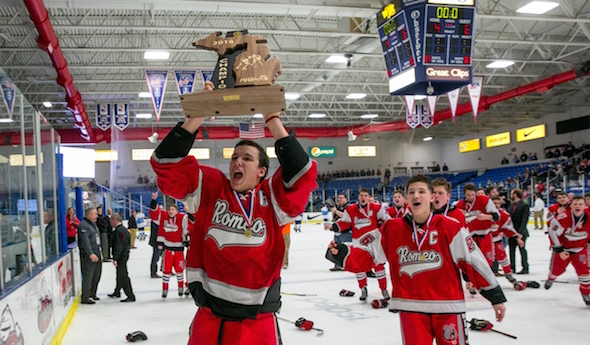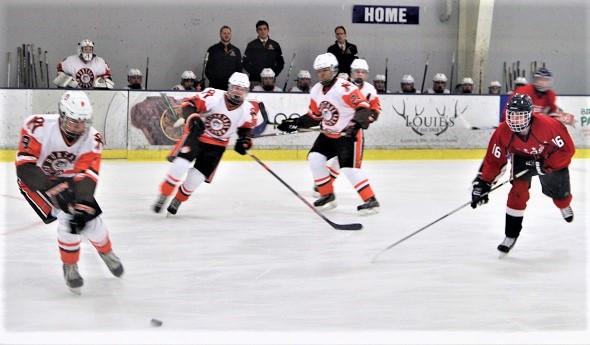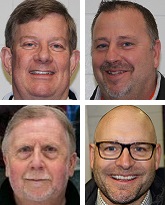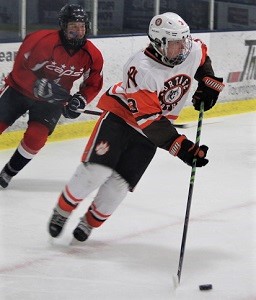
Hockey Team Becomes Romeo's Next Champ
March 12, 2016
By Bill Khan
Special for Second Half
PLYMOUTH — The students in the large Romeo cheering section might have been nervous.
Some of his teammates might have been getting nervous too.
Nolan Kare, however, couldn't allow himself to give in to the natural human reaction as the MHSAA Division 2 hockey championship appeared to be slipping away from the Bulldogs' grasp.
After scoring three straight goals during a frantic 5:02 stretch of the second period, a seasoned Livonia Stevenson squad held a 4-2 lead over a Romeo team that had never played on the biggest stage in Michigan high school hockey.
Kare stopped the last 11 shots he faced over the final 22 minutes and 21 seconds, backstopping Romeo to a 6-4 come-from-behind victory over Stevenson on Saturday at USA Hockey Arena.
"I know we kind of let up a little bit, but our team has so much heart," Kare said. "I know that if I just make the saves I'm supposed to make and try to rob a few that our team is going to give us the best chance to win. I know if I'm doing that, then I'm going to give them the best opportunity to put us in a position to get back."
Senior star Logan Jenuwine's tip-in goal during a five-minute power play with 10:21 left in the game snapped a 4-4 tie. Steven Morris scored an empty-net goal with 29.1 seconds left to seal the first MHSAA hockey title in the 15-year history of the Romeo program.
Suddenly, a school that had no MHSAA team championships going into the 2014-15 school year has three over the past 16 months. It began with the volleyball team winning the 2014 Class A championship and continued when the football team upset Detroit Cass Tech in the 2015 Division 1 title game at Ford Field.
"Before the game, we were saying if the football team could beat Cass Tech with 20 Division I (college) players coming up, we could beat Livonia Stevenson," Romeo senior forward Nick Blankenburg said. "Shocking the world and being part of such a great team feels incredible. To win a state championship for our school, to get those rings like our football team and volleyball team, I'll remember this my entire life."
Like the football and volleyball teams, the hockey team benefitted from a huge outpouring of support in a matchup that was witnessed by two passionate and energized fan bases.
"There's just something special about Romeo," said Kare, who finished with 29 saves and led the state with all 27 of Romeo's victories. "It's a small-town feel. You could see it out there. The entire town's out there for us. Just like football, just like volleyball, we had the whole community behind our back. We're just unbelievably blessed to have the best fan base, the best family, the best support out of anybody."
The atmosphere in which the Romeo and Stevenson players competed is one of the things that sets high school hockey apart from its competitors. Senior forward Ben Kowalske, who played in three MHSAA Finals for the Spartans, said neighbors will stop him and congratulate him on how the team is performing. Kowalske is the lone holdover from Stevenson's 2013 MHSAA Division 2 championship team and is a member of the MHSAA's Student Advisory Council.
"Being on the Council, you learn ideas and what other schools do," Kowalske said. "It's really amazing people are so interested in what we're doing. To have everyone come out to the game really means the world and really means a lot to us that we're doing something right here. You saw Romeo, too. They had the city support. It's cool. You try not to let it distract you during the game, but now that it's over, it's cool. It wasn't the outcome we wanted, but we did the best we could. It's really cool the community could come together over something and just forget about the world for a couple hours and just have fun."
 A defensive battle that was tied 1-1 for the first 23 minutes changed in a hurry as the second period neared its midway point.
A defensive battle that was tied 1-1 for the first 23 minutes changed in a hurry as the second period neared its midway point.
Romeo (27-2-1) grabbed a 2-1 lead at 6:18 of the second period on a goal by Jenuwine, but that only served to wake up the Spartans.
As Jenuwine's goal was being announced, Nick Beers scored the equalizer for the Spartans just 19 seconds later. Stevenson took its first lead 44 seconds later on a goal by Shane Leonard. Riding the crest of that momentum, the Spartans built their lead to 4-2 at the 11:39 mark on a goal by Nate Sudek.
With the game possibly slipping away, Romeo coach Nick Badder called what proved to be a critical timeout.
"We were down, they had all the momentum," Badder said. "I was telling (Adam) Krefski and the other assistants, 'Right now, they have all the momentum. We're on our heels, and we felt it. We calmed down the boys. Once they calmed down and realized it was shift by shift, we kind of took over."
Romeo got right back into the game before the second period ended, getting within 4-3 on Brett Lanski's second goal of the game with 2:34 left in the period and tying it when Luke Kaczor tipped in a shot from the point by Logan Ganfield with 1:30 to go in the period. Between the teams, six goals were scored during a 9:13 span.
Romeo was presented with a golden opportunity to break the tie when a Stevenson player received a five-minute major and game disqualification at 4:38 of the third period.
A power play that featured the highest-scoring player in the state wasn't going to miss over the course of five minutes. Jenuwine, who had 46 goals and 50 assists this season, scored what proved to be the game-winner at the 5:39 mark when he redirected a shot from the right point by Ganfield.
"It was going wide," said Jenuwine, who had two goals and three assists. "That's what I've been trying to work on mostly is get to the front of the net. I'm not really a guy to get to the front of the net; I did. It was a good shot by Logan Ganfield, and I got a tip on it."
Stevenson coach David Mitchell didn't blame the penalty for the loss.
"To say it turned there, it turned because they capitalized," Mitchell said. "They still had to capitalize, so you give them credit for capitalizing. We still had multiple chances to score and they had multiple chances to score. As a coach, it's so tough to explain to a bunch of 15-, 16-, 17-year-old kids that it's not one moment, it's an entire game. There were 51 minutes that were played out there where multiple other things happened."
Stevenson (22-7-1) had three offensive-zone face-offs in the final 1:25, but couldn't generate a scoring threat.
There might have been another had Morris' shot from inside his own blue line missed the target, but he found the center of the net for the game-clinching empty-netter with 29.1 seconds to go. For good measure, Morris blocked a shot in the final seconds.
Before Saturday, the Bulldogs' only playoff run beyond the Regionals came last season when they lost 8-2 to Grosse Pointe South in the MHSAA Quarterfinals.
"Last year's loss in the playoffs hurt," Badder said. "Grosse Pointe South took it to us; they kind of owned us. We didn't have a playoff game plan; we didn't have a playoff style last year. This year, I was so hard on these guys. We lost two games, and I was still, 'Guys, we're not doing this right, we're not doing that right.' They're like, 'Coach, we just won 6-1.' I was trying to get a point across to them that you've got to be a playoff team. You have to hit. You've got to block shots. You've got to get the puck in your own end. It's not the high-flying (Blankenburg) and (Jenuwine) show. We're a team, and the team will win in the end."
PHOTOS: (Top) Romeo players raise their first MHSAA championship trophy to the crowd after Saturday’s Division 2 Final. (Middle) Romeo’s Steven Morris (36) and Stevenson’s Sam Judd work to gain possession of the puck. (Click for more from Andrew Knapik.)

CAAC, SW Teams Find Home in New League
By
Pam Shebest
Special for MHSAA.com
January 21, 2020
Two struggling hockey leagues found a perfect match, thanks to the behind-the-scenes work of commissioners, athletic directors and coaches.
 The Capital Area Activities Conference, a multi-sport league, had just four hockey teams.
The Capital Area Activities Conference, a multi-sport league, had just four hockey teams.
The Southwest Michigan High School Hockey League was down to five.
Merging the two leagues was a no-brainer for all involved.
“We learned (the CAAC) was a small league like us,” Portage Northern athletic director Chris Riker said. “It’s tough to have a league with just five teams. By putting our two leagues together, and we had already played a lot of those teams, it just made a lot of sense.”
The new 10-team league, called the South Central High School Hockey League, is bringing a new excitement to both areas and came together very smoothly in less than a year.
Forming a new league boiled down to one thing: “survive and thrive,” said Randy Allen, a former MHSAA assistant director and retired CAAC commissioner.
“I’m tickled pink, and I give high marks to the coaches and athletic directors.”
The league is divided into the Central and South divisions, with five teams in each.
Most teams in the league are co-op teams with Jackson Lumen Christi in the Central and Mattawan, Portage Central and Portage Northern in the South the only teams made up of students from one school.
Other teams in the Central Division are the Capital City Capitals (DeWitt, Lansing Catholic, Mason, St. Johns), Mid-Michigan Marauders (Holt, Grand Ledge, Eaton Rapids, Portland, Potterville), East Side Stars (East Lansing, Williamston, Haslett, Bath, Laingsburg) and Okemos (with Fowlerville).
 Co-op teams in the South are the Kalamazoo Eagles (Gull Lake, Battle Creek Harper Creek, Battle Creek Pennfield, Paw Paw, Parchment, Plainwell) and Kalamazoo United (Loy Norrix, Kalamazoo Central, Hackett Catholic Prep).
Co-op teams in the South are the Kalamazoo Eagles (Gull Lake, Battle Creek Harper Creek, Battle Creek Pennfield, Paw Paw, Parchment, Plainwell) and Kalamazoo United (Loy Norrix, Kalamazoo Central, Hackett Catholic Prep).
The first big showcase event featuring all 10 teams is set for Friday and Saturday at Wings West in Kalamazoo.
“One of the other cool things about this new league is we’re bringing them all together for the ‘Annual Youth Hockey Fights for Autism’ at Wings West Feb. 15, and all 10 teams will be playing,” said Frank Noonan, commissioner of the old SWMHSHL and now commissioner of the new league.
Riker said the new league “creates some excitement the way we structured the season with playing in your division and playing crossover games.
“We’re going to have a big championship game where the two No. 1 teams play each other, the second-place teams meet and so on (Feb. 22 at Wings West).”
There are other benefits as well, Noonan said.
“The best thing for hockey in the area is they have set opponents they’re going to play every year and, for the kids who earn (end-of-season) awards, it means more,” he said.
“There are 10 teams competing for the awards rather than our typical six-team old division, so it’s more prestigious, more of an honor to win an award in the new league.”
MHSAA Assistant Director Cody Inglis, who took over administration of hockey for the Association when Allen retired in 2014, put Riker – a member of the MHSAA’s Representative Council – in touch with Allen. The two jump-started talks last March.
One key was getting the Eagles to become a school-based team rather than a club one.
“Karyn Furlong (Gull Lake athletic director) was willing to jump on and sponsor the Eagles,” Riker said. “She did all the leg work in getting the schools on board.
“The Eagles organization also deserves a lot of recognition for saying, hey, we’ve been in this club status and now we’re willing to come in and be a school sport.
“Now they have the opportunity to play in the state tournament, which they’ve never had.”
The MHSAA Semifinals and Finals are set for March 12-14 at USA Hockey Arena in Plymouth.
Allen, who went on to serve as commissioner of the CAAC until retiring at the start of this school year, first floated the idea of merging the two leagues to coaches from his conference.
“They were all in favor of it,” he said. “(Inglis) talked with (Riker), and we met to talk.
 “At the athletic directors conference (in March 2019), we kept inching closer to forming a new league. We did not hear one word of objection through the entire process. We had 110-percent backing.
“At the athletic directors conference (in March 2019), we kept inching closer to forming a new league. We did not hear one word of objection through the entire process. We had 110-percent backing.
“After everybody covered all the bases, we made it final and came up with the official name.”
Allen said the new league has “great leadership from the athletic directors and (Noonan), who took the lead on everything.”
He added that one perk of the new league is getting officials together. “Now we get officials to be part of one overall group, and there is a possibility of mentoring,” Allen added.
Capital City Capitals coach Travis Van Tighem likes the new league.
“It’s great to get some more natural rivals,” he said. “Our league got to be so small we played a lot of other (non-league) teams or showcase games.
“When more games have meaning or some substance to them, you can see kids growing and there are some natural rivalries that it creates, so it’s exciting.”
Travel is not a problem, Van Tighem added.
“For us in Mid-Michigan, it you go outside the Lansing area, it’s going to be an hour anyway. So coming to Kalamazoo, it’s an hour 20 or hour 15, but if we go anywhere else, except for Jackson, it’s going to be at least an hour,” he said.
“Athletic directors and coaches got together, and it really came together nicely. It’s been great so far.”
Other league facilities besides Wings West are Optimist Ice Arena (Jackson), Summit Sports and Ice Complex (Dimondale) and Suburban Ice (East Lansing).
 Pam Shebest served as a sportswriter at the Kalamazoo Gazette from 1985-2009 after 11 years part-time with the Gazette while teaching French and English at White Pigeon High School. She can be reached at [email protected] with story ideas for Calhoun, Kalamazoo and Van Buren counties.
Pam Shebest served as a sportswriter at the Kalamazoo Gazette from 1985-2009 after 11 years part-time with the Gazette while teaching French and English at White Pigeon High School. She can be reached at [email protected] with story ideas for Calhoun, Kalamazoo and Van Buren counties.
PHOTOS: (Top) Portage Northern and Capital City face off in an SCHSHL crossover Jan. 9 at Wings West. (Middle) Clockwise from top left: Frank Noonan, Chris Riker, Travis Van Tighem and Randy Allen. (Below) Northern’s Nolan McCarthy (3) charts his next move with the puck. (Photos by Pam Shebest.)

